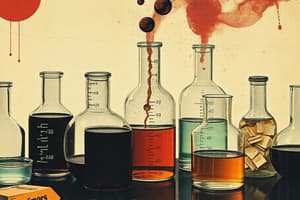Podcast
Questions and Answers
What is the primary characteristic that distinguishes a mixture from a compound?
What is the primary characteristic that distinguishes a mixture from a compound?
- Mixtures are always homogeneous, while compounds can be heterogeneous.
- Mixtures have unique chemical properties, while compounds have variable properties.
- Mixtures can be separated through physical processes, while compounds require chemical processes. (correct)
- Mixtures involve chemical bonding between components, while compounds do not.
Which of the following is an example of a double displacement reaction?
Which of the following is an example of a double displacement reaction?
- 2Na + 2HCl → 2NaCl + H2
- 2NaCl + CaCl2 → 2NaCl + Ca(OH)2 (correct)
- 2Na + 2HCl → 2NaCl + H2
- 2H2O → 2H2 + O2
Which of the following properties is characteristic of a colloid mixture?
Which of the following properties is characteristic of a colloid mixture?
- The components have variable concentrations.
- The components are chemically bonded.
- The components can be easily separated by filtration.
- One substance is dispersed throughout another substance. (correct)
What is the primary difference between a synthesis reaction and a decomposition reaction?
What is the primary difference between a synthesis reaction and a decomposition reaction?
Which of the following statements about the properties of compounds is NOT true?
Which of the following statements about the properties of compounds is NOT true?
What happens during a chemical reaction?
What happens during a chemical reaction?
Which property of substances refers to their ability to dissolve in specific solvents?
Which property of substances refers to their ability to dissolve in specific solvents?
What characteristic makes elements unique in their chemical properties?
What characteristic makes elements unique in their chemical properties?
Which of the following is NOT an element?
Which of the following is NOT an element?
What defines a mixture?
What defines a mixture?
Flashcards are hidden until you start studying
Study Notes
Chapter 14: Substances
This chapter explores various aspects of substances, delving into concepts such as chemical reactions, properties of substances, elements, mixtures, and compounds.
Chemical Reactions
A chemical reaction occurs when substances break apart or combine to form one or more new substances. During a chemical reaction, bonds break and new bonds form, resulting in the formation of new products with distinct chemical properties compared to their original components. For example, hydrogen and chlorine can react to form hydrogen chloride, where the bond between hydrogen atoms breaks and the bond between the chlorine atoms breaks, followed by the formation of new bonds between hydrogen and chlorine atoms.
Properties of Substances
Substances display a range of physical and chemical properties that help define them. These properties include density, melting, boiling points, and solubility in certain solvents. Elements, in particular, have unique atomic structures leading to consistent chemical behavior within a group.
Elements
Elements are fundamental building blocks of matter comprised of only one species of atom, unique in their chemical properties. Each element has a specific atomic structure consisting of protons, neutrons, and electrons that govern their behavior in various processes. Some common elements include hydrogen, carbon, oxygen, nitrogen, calcium, potassium, aluminum, phosphorus, sodium, magnesium, sulfur, chlorine, argon, and hydrogen.
Mixtures
A mixture is a combination of two or more components that are not chemically bonded. These components can be separated through physical processes such as filtration, evaporation, or distillation. Some common types of mixtures include solutions (homogeneous), colloids (mixtures where one substance is dispersed in another), and suspensions (where particles settle out over time). The properties of these mixtures depend on the constituents present and their relative concentrations.
Compounds
Compounds are formed when atoms from different elements combine via chemical bonds. They exhibit unique chemical properties due to the arrangement of electrons between the constituent atoms. Compounds can be classified into various categories based on the type of chemical reaction involved, such as synthesis reactions (formation of new compounds), decomposition reactions (breakdown of existing compounds), single displacement reactions (exchange of atoms within a compound), and double displacement reactions (exchange of ions between two compounds).
Understanding these subtopics provides a foundation for exploring deeper aspects of chemistry, including thermochemistry, stoichiometry, equilibrium, and nuclear chemistry. Each concept builds upon this fundamental understanding of substances and their interactions.
Studying That Suits You
Use AI to generate personalized quizzes and flashcards to suit your learning preferences.




